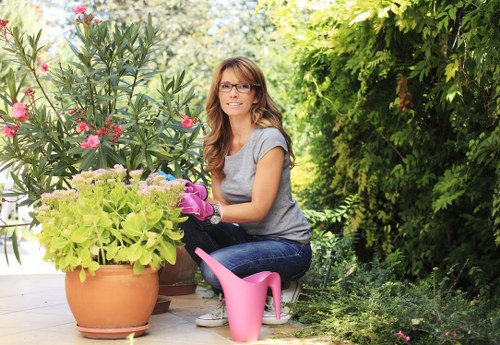Stump Removal in Garden Maintenance: A Comprehensive Guide

Maintaining a beautiful and safe garden involves various tasks, one of which is stump removal. Stumps can be unsightly, pose safety hazards, and hinder the growth of new plants. Understanding the best methods for stump removal is essential for effective garden maintenance.
Stump removal not only enhances the aesthetic appeal of your garden but also prevents pests and diseases from taking hold. Whether you're a seasoned gardener or a homeowner looking to improve your outdoor space, this guide will provide you with the necessary information to tackle stump removal efficiently.
In this article, we'll explore different stump removal techniques, their benefits, and considerations to help you make an informed decision for your garden maintenance needs.

Why Removing Tree Stumps is Important
Tree stumps can create several issues in your garden, making their removal a crucial aspect of garden maintenance. Here are some key reasons why you should consider removing tree stumps:
- Aesthetics: Stumps can disrupt the visual harmony of your garden, making it look untidy and neglected.
- Safety: Protruding stumps can cause trips and falls, especially in areas frequented by children and pets.
- Pest Prevention: Stumps can attract termites, ants, and other pests that may spread to other plants and structures.
- Space Utilization: Removing stumps frees up space for new plants, trees, or garden features.
- Preventing Disease: Decaying stumps can be a breeding ground for fungal infections that may affect nearby vegetation.
By addressing these issues, stump removal contributes to the overall health and beauty of your garden.

Methods of Stump Removal
There are several methods available for stump removal, each with its own set of advantages and considerations. The choice of method depends on factors such as the size of the stump, your budget, and whether you prefer a DIY approach or professional assistance.
Mechanical Removal
Mechanical stump removal involves using specialized equipment to grind or excavate the stump from the ground. This method is highly effective and suitable for large stumps.
- Stump Grinders: These machines grind the stump into small wood chips, making it easier to remove.
- Excavators: Heavy machinery can dig out the entire stump, including the roots, for complete removal.
While mechanical removal is efficient, it may require renting equipment or hiring professionals, which can be costly.

Chemical Removal
Chemical stump removal involves applying chemicals to accelerate the decomposition of the stump. This method is less labor-intensive but takes longer to achieve results.
- Chemical Accelerants: Substances like potassium nitrate break down the wood fibers, making the stump easier to remove.
- Safety Considerations: It's important to handle chemicals carefully to avoid environmental contamination.
Chemical removal is a cost-effective option, especially for smaller stumps, but patience is required as the process can take several weeks.

Natural Decay
The most eco-friendly method of stump removal is allowing it to decay naturally. This process relies on natural elements like insects, fungi, and weather conditions to break down the stump over time.
- Time-Consuming: Natural decay can take several years, making it the slowest method.
- Low Cost: This method requires minimal financial investment, relying instead on nature to do the work.
- Aesthetic Integration: As the stump decays, it can become part of the garden's ecosystem, enriching the soil.
While natural decay is environmentally friendly, it may not be suitable if you need immediate stump removal.
Choosing the Right Method for Your Garden
Selecting the appropriate stump removal method depends on various factors. Here are some considerations to help you decide:
- Stump Size: Larger stumps may require mechanical removal, while smaller ones can be managed with chemical or natural methods.
- Budget: Consider the cost implications of each method, including equipment rental or chemical purchases.
- Timeframe: If you need quick results, mechanical removal or chemical methods are preferable over natural decay.
- Environmental Impact: For eco-conscious gardeners, natural decay offers a sustainable option.
- DIY vs. Professional Help: Assess your ability and willingness to undertake the removal process yourself or hire experts.
Evaluating these factors will guide you in selecting the most suitable stump removal technique for your garden.
Hiring Professional Stump Removal Services
While DIY stump removal is feasible, hiring professionals can offer several advantages:
- Expertise: Professionals have the experience and knowledge to handle various stump removal scenarios effectively.
- Equipment: They possess specialized tools that can expedite the removal process.
- Safety: Professionals are trained to manage the risks associated with stump removal, ensuring a safe operation.
- Time-Saving: Hiring experts can significantly reduce the time required to remove stumps.
Investing in professional stump removal services can provide peace of mind and assure that the job is done correctly.
Cost of Stump Removal
The cost of stump removal varies based on the chosen method, stump size, and whether you opt for professional assistance:
- Mechanical Removal: Typically ranges from $100 to $400 per stump, depending on the equipment used and accessibility.
- Chemical Removal: Costs around $50 to $150, including chemicals and labor if hiring professionals.
- Natural Decay: Minimal to no cost, but requires a long-term commitment.
It's advisable to obtain quotes from multiple service providers to ensure competitive pricing for professional stump removal.
Preventing Future Stump Issues
After removing a stump, taking preventive measures can help maintain the beauty and health of your garden:
- Proper Disposal: Dispose of the removed stump responsibly, either by chipping, composting, or contacting local waste management services.
- Soil Restoration: Fill the hole with soil and consider planting grass or other vegetation to restore the area.
- Regular Maintenance: Monitor your garden for new stumps and address them promptly to prevent future issues.
- Plant Selection: Choose tree species that align with your garden's maintenance capacity and aesthetic preferences.
Implementing these practices ensures a well-maintained garden free from obstructive stumps.
Eco-Friendly Stump Removal Tips
Adopting environmentally friendly stump removal methods promotes sustainability and reduces your garden's ecological footprint:
- Use Natural Decay: Embrace the natural decomposition process by encouraging insects and fungi to break down the stump.
- Replanting: Replace the removed stump with native plants or trees to maintain biodiversity.
- Composting Wood Chips: Utilize the wood chips from mechanical removal as mulch or compost to enrich your soil.
- Avoid Harmful Chemicals: If opting for chemical removal, choose eco-friendly products that minimize environmental impact.
By prioritizing eco-friendly practices, you contribute to a healthier and more sustainable garden ecosystem.
Contact us today to schedule professional stump removal services and transform your garden into a safe and beautiful space.
Ensure your garden remains pristine and free from unwanted stumps by taking proactive maintenance steps. Whether you choose mechanical, chemical, or natural removal methods, addressing stump issues promptly enhances your garden's overall appeal.
Don't let tree stumps detract from your outdoor enjoyment. Invest in effective stump removal solutions and enjoy a flourishing garden all year round.
Frequently Asked Questions
How long does stump removal take?
The duration of stump removal depends on the method used. Mechanical removal typically takes a few hours, chemical removal can take several weeks to months, and natural decay may take several years.
Can I remove a stump myself?
Yes, smaller stumps can be removed using DIY methods like chemical treatments or manual digging. However, larger stumps often require professional equipment and expertise.
Is stump removal harmful to the environment?
When done responsibly, stump removal can be environmentally friendly. Opting for natural decay or eco-friendly chemicals minimizes the environmental impact.
What to do with the wood from the removed stump?
The wood can be chipped and used as mulch, composted, or repurposed for woodworking projects, depending on its condition and your garden needs.
How can I prevent stumps from forming?
Regular tree maintenance, such as pruning and removing diseased trees promptly, can reduce the likelihood of unwanted stumps forming in your garden.
Conclusion
Stump removal is a vital component of effective garden maintenance. By understanding the various removal methods and their respective benefits, you can maintain a safe, attractive, and healthy garden environment. Whether you choose mechanical, chemical, or natural removal, addressing stump issues promptly ensures your garden remains a source of pride and enjoyment.
Take the necessary steps today to manage and remove tree stumps, and transform your garden into a beautiful and thriving outdoor space.
Book your service now and let our experts assist you in achieving the perfect garden you've always desired.